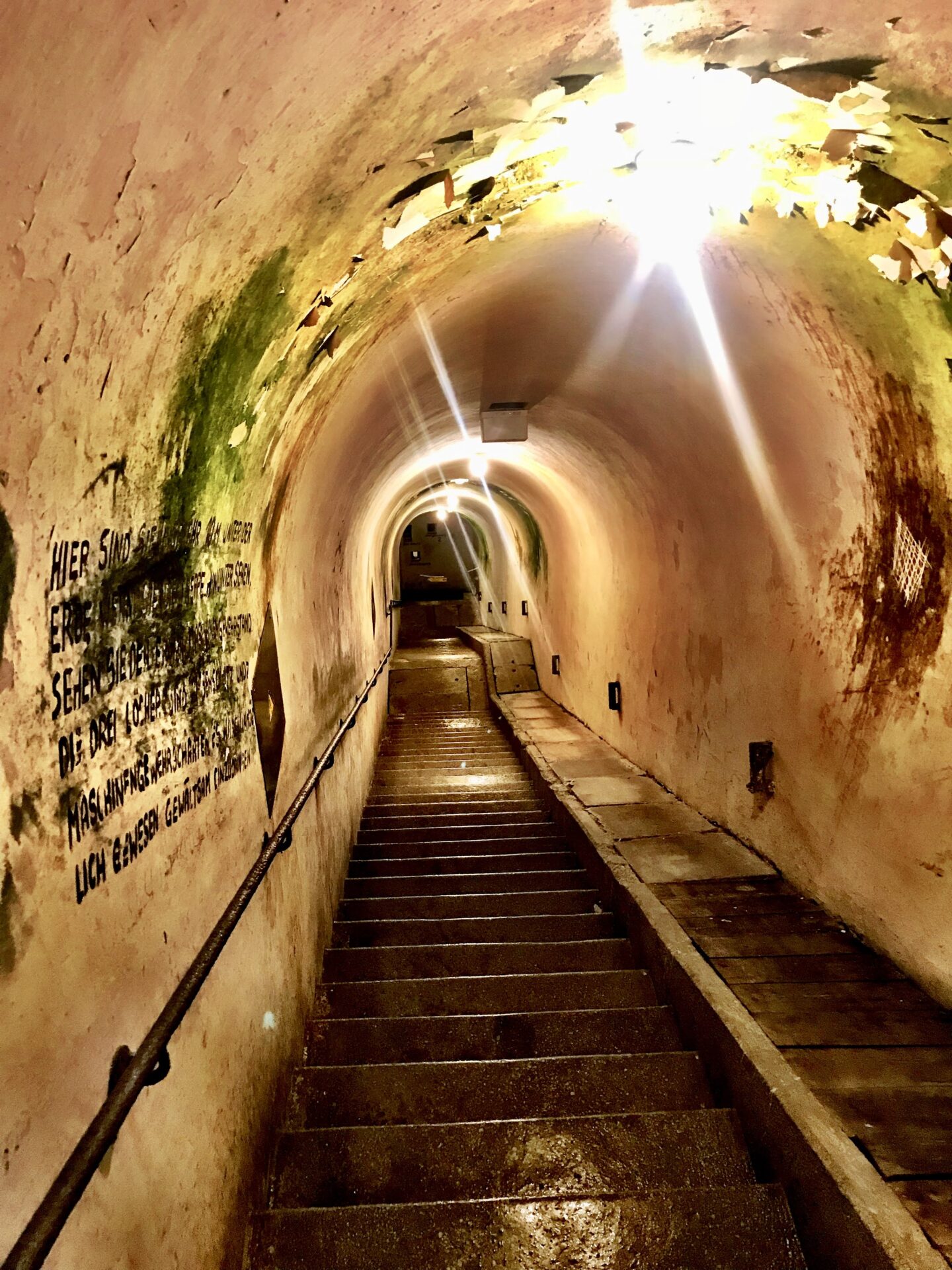I was standing on the floor of what used to be The Berghof, or Hitler’s house. It’s always been hard for me to think of the world’s most hated man as being a real person, but he had a house, a girlfriend, he painted and he lived in one of the most beautiful areas of Bavaria. His home was obliterated off the map by Allied forces, but there are little bits of his life and places that are mysteriously still in existence. In spite of how people feel about Hitler, plus the fact that vacations traditionally are supposed to be about “happy things”, tourists still flock to concentration camps by the droves.Nazi tourism is at an all-time high. Perhaps it’s to gain an understanding of how things in the world went so terribly wrong. Maybe it’s akin to the fascination of watching a horror movie.
After Hitler wrote “Mein Kamph” he used the money from the sale of his book to buy a small chalet in Bavaria near the border of Austria. He soon expanded the building, named it the “Berghof” and was soon followed by several of his henchmen who also moved into the neighborhood. He tried to purchase the Zum Turken hotel next door but the owner refused to sell. After being sent to Dachau concentration camp for 2 weeks, the owner changed his mind. The hotel was used to house the SS, but there was a fear of being attacked by Allied forces, so defenses were put into place.
In 1945 as the Germans were losing WW2, the entire neighborhood was bombed, Hitler’s house set on fire and the remaining walls eventually torn down a few years later. Over the last 70 years the trees have grown back, the Zum Turken hotel rebuilt and the town looks like a pristine mountain resort. However, walk down the road into the trees and you can still find part of the foundation and driveway of Hitler’s house. It seems creepy enough to be walking in the place that Hitler spent most of his time, but the most bizarre secret lies beneath the Zum Turken hotel. Pay a few Euros, climb down the stairwell and you are in the remaining area of Hitler’s tunnels. You can see the holding cell for short term prisoners, corridors that went to the different Nazi’s homes and secure bunker rooms where soldiers could safely shoot anyone with their machine guns behind the safety of several feet of cement. It’s a sobering DIY tour and hard to believe that such a place still exists.
Equally bizarre is the famed Eagle’s Nest, one of the few Third Reich buildings left in the world. The building was originally a gift to Hitler for his 50th birthday. It was constructed not far from his home, but high on a neighboring mountain top. Hitler didn’t love the place as much as his contemporaries hoped because of his fear of heights and his dislike of the frequent bad weather. He did however visit the mountain retreat over a dozen times for various meetings. Somehow the building was miraculously spared during the allied bombings. After the Nazis were deposed, the allies used it as a military command post until 1960. Now the complex has been re-purposed as a restaurant and beer garden. You can take a bus to the top of the mountain, ride the elevator to Hitler’s former headquarters and have a beer and some German sausage. Ironic, but true. Hitler’s study has been demoted into restaurant storage.
From Obersalzburg, you can drive straight north an hour and 1/2 north and arrive in the small town of Braunau am Inn. It’s a small Austrian town that’s main claim to fame (or infamy) is that it’s the birthplace of Adolphus Hitler. The building where he was born remains intact to this day in spite of efforts to tear it down. The current owner of the building is involved in a legal battle with the Austrian government over the seizure of the property. Fears that neo-nazis or other radical groups might gain control over the area and use it as a “mecca” for their ideologies has caused a lot of controversy. As a tourist, you can’t get inside the building, but there’s a large monument in front of the house commemorating Hitler’s victims and a great little bakery across the street if you’d like to clear your mind and have some amazing strudel. If you drive an hour and 1/2 east of here, you will come across Hitler’s childhood home in Leonding, just south of Linz where he lived for seven years. Neither homes offer the visitor a lot to see other than the building exteriors, but it’s interesting that these structures have survived, are mostly unknown by tourists and have never been turned into museums.
Dachau and Auschwitz are the most popular concentration camps to visit for a gristly reminder of the atrocities committed by Hitler’s Third Reich. Auschwitz is the most comprehensive of the two and has 3 remaining camps in the southwest corner of Poland, but it’s a bit of a drive from Germany. Dachau is in a suburb between Munich and the airport and is easily accessible if you’re visiting Bavaria. It’s difficult to believe the torture, scientific experiments and human abuse that took place in the quiet suburb that reportedly went unnoticed by the local residents. Auschwitz was a much more blatant death camp where prisoners were incarcerated, stripped of their belongs, gassed and burned with no mercy. You can still see the ruins of the buildings where this took place. Sachsenhausen and Bergen-Belsen are also former death camps located in northern Germany that can be visited. Bergen-Belsen is notable as the camp where Ann Frank died from typhus.
Hitler spent his last days in Berlin at the Fuhrerbunker, an underground complex created to protect him and it’s other residents from air raids. Realizing that he was about to be captured, he hurriedly married his girlfriend Eva Braun, then the two of them took cyanide pills and Hitler then shot himself in the head. Both bodies were burned according to his orders. Unlike his childhood homes, the Fuhrerbunker was not spared. The soviets leveled it and residential buildings and a parking lot were put over the bunker so there would not be a trace of anything. In 2006 a sign was placed at the site and has become a popular stop for Berlin tours.
Over the years, Germany has come to terms with it’s horrific past. Nationals don’t like to be constantly reminded of a past that has little to do with them, but the German government has made a big effort to keep their history accessible so that future generations can learn from their mistakes. Visiting these places is fascinating; not the same fun as visiting castles or celebrating Oktoberfest, but definitely worth taking a day or two out of your next trip in Europe to visit.





